Roses
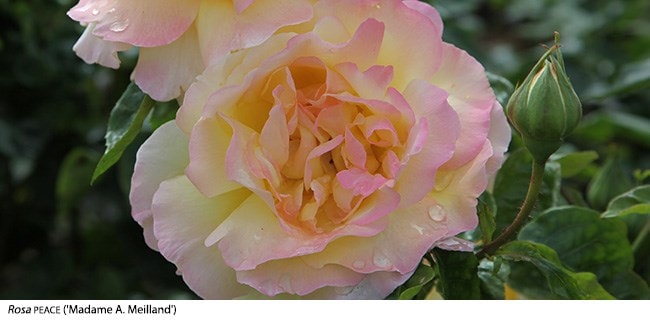
The rose has been the nation’s favourite flower for centuries, and it's easy to see why with their wonderfully fragrant blooms that come in so many different forms and colours. They are the staple for the cottage garden and create a quintessentially British look when planted with Lavenders, Peonies, Nepeta, Geraniums (the list could go on and on).
Planting Tips
All our roses are field grown. They are usually dug up in October/November (depending on the weather), and plunged into pots for you to plant while they are dormant. Now, when it comes to planting the golden rule is to plant them when the weather allows. Do not plunge your new roses into icy soil, they won’t like this. It is best to prepare the ground and then cover it with either bubble wrap, cardboard, an old carpet or anything else that will prevent frost penetrating the ground. Then that is the hard work done! If you can’t do this, and your roses happen to arrive in hard weather, bide your time and keep them against the house wall until the frost and cold retreat. They will not mind at all.
When planting look at your roses carefully and position them so that the three or four splaying stems can be seen to best advantage, because every plant has a front and back. The compost will probably fall away, so add it to your planting hole. Don’t be afraid to trim any stems, BUT always back to an outside-facing bud. You can also shorten any over-long roots if it makes planting easier.
Never add manure when planting as it may scorch the roots. Garden compost can be used, but generally a well-dug garden soil is fine. If you’re replacing a rose with another, it’s best to replace the exhausted soil before planting. John Innes no 3 compost is a good, easy solution. Also you could add some rose rootgrow, - a mycorrhizal fungi added into the planting hole before you plant the rose, or actually sprinkle it onto the roots to help them establish. It is important that this fungus is in contact with the roots.
Now which one to choose…...
Once and Only or Repeat-flowering?
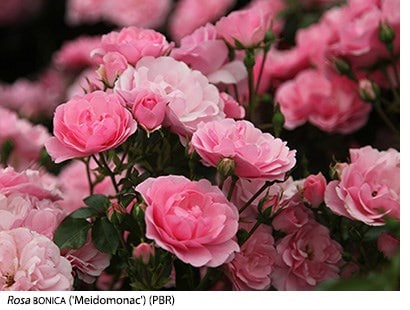 Modern roses are generally bred to be repeat-flowering with a main flush in June, followed by further flowers throughout the season. These roses ration their flowers with five to six weeks between flushes, finishing with a late flourish in October, or even November. All repeat-flowering roses need deadheading regularly to encourage more bloom. They also need feeding, both before (in early spring) and after their first flush, to keep them healthy and floriferous - Vitax Q4 is good as it is easy to sprinkle on and long-lasting with lots of flower-boosting potash.
Modern roses are generally bred to be repeat-flowering with a main flush in June, followed by further flowers throughout the season. These roses ration their flowers with five to six weeks between flushes, finishing with a late flourish in October, or even November. All repeat-flowering roses need deadheading regularly to encourage more bloom. They also need feeding, both before (in early spring) and after their first flush, to keep them healthy and floriferous - Vitax Q4 is good as it is easy to sprinkle on and long-lasting with lots of flower-boosting potash.
Once and only-flowering roses are glorious in June, before fading away for good. However their branches drip with masses of flower for two or three weeks, adding great glory to the summer garden. Every gardener should aspire to plant a few for this reason, but there is no point in deadheading or feeding them after flowering because their work is done for the year. Just feed them once a year in early spring, just as the roses begin to grow.
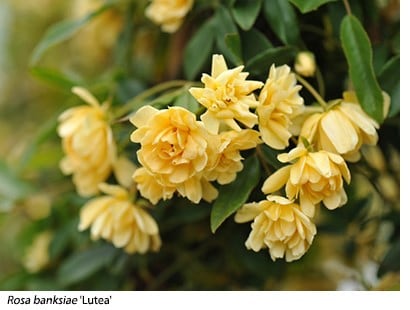
Rambling roses are nearly always once and only flowering, producing new growth from the base every year. Many are vigorous and capable of scrambling into a mature tree, or covering a building given five or so years. ‘Paul’s Himalayan Musk’ could be mistaken for apple blossom from a distance, with its soft-pink sprays of double rosettes rising above small sea-green leaves. It has a graceful habit of cascading downwards, so this musk-scented rose is an excellent addition. The double flowers last for four weeks at least, and this rose is expansive but not overwhelming. Rosa banksiae 'Lutea' is a pretty rose with sprays of small double, deep yellow flowers with the added benefit of being thornless, so great for covering an arch or pergola over a path. Plant it in a sheltered sunny spot as it isn't totally hardy.
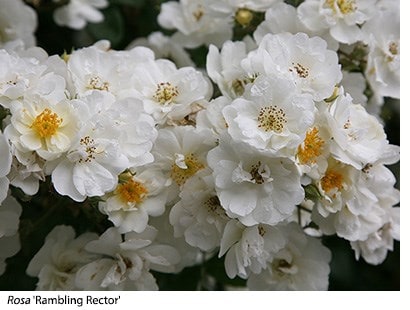 The white ‘Rambling Rector’, often known as Shakespeare’s Musk, is less feisty. The cream-white, semi-double flowers age to white, above greyish green foliage that never shows any disease. Small hips follow for autumn colour. The growth is more rigid, but it will scale a tree, or cover a shed quite happily. ‘Wedding Day’ has lemon buds that produce single white flowers with lots of golden stamens. The flowers age and develop a pale-pink blush. Finally the blue-purple ‘Veilchenblau’ is glorious planted on light stone walls in a sunny position, where it will turn purple - a unique colour in rambling roses.
The white ‘Rambling Rector’, often known as Shakespeare’s Musk, is less feisty. The cream-white, semi-double flowers age to white, above greyish green foliage that never shows any disease. Small hips follow for autumn colour. The growth is more rigid, but it will scale a tree, or cover a shed quite happily. ‘Wedding Day’ has lemon buds that produce single white flowers with lots of golden stamens. The flowers age and develop a pale-pink blush. Finally the blue-purple ‘Veilchenblau’ is glorious planted on light stone walls in a sunny position, where it will turn purple - a unique colour in rambling roses.
Planting Close to a Tree
When planting against a large tree, dig a hole about a metre away from the trunk and angle the rose towards the trunk. The tree must be mature and strong enough to take the weight of the rose. Or you can train the rose up to the crown of branches, using wooden supports. In this case the rose should be planted on the outer reaches of the tree's canopy. Allow it to scramble up the supports and then into your chosen tree. Keep all roses well-watered in their first growing season.
Ground Cover
It’s worth considering planting ramblers on a steep bank for ground cover, so that they tumble downwards as they do at Crathes Castle in Scotland. Or you may consider the low-growing Flower Carpet roses, which are good at covering rough ground and need little maintenance other than a yearly trim with a strimmer. This sounds harsh, but it works. ‘Flower Carpet Sunshine’ is a good choice, or plant the Country Series that include the white ‘Kent’, or the frilly pink ‘Surrey’. Flower Carpet and the Country Series are both grown in RHS Wisley’s Rose Garden, so don’t dismiss them just because they’re low-growing ground cover. They’re prolific and strong, but gentle on the eye.
Climbing and ‘Pillar’ Roses
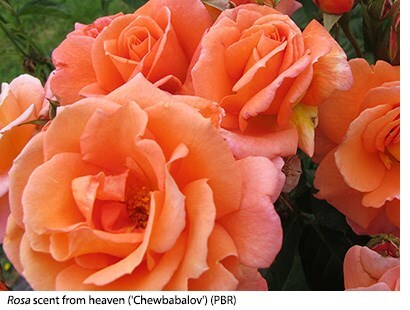 Many climbing roses have over-large flowers on leggy stems, due to their old-fashioned Hybrid Tea blood. Their pliable stems are ideal for winding around a pillar before the new growth hardens, usually in October and November. This slows the sap and helps produce more flowers.
The Rose of the Year 2017 - Scent from Heaven ('Chewbabalov') is a gorgeous repeat flowering climbing rose, with beautiful, fragrant, rich apricot-orange blooms which can appear from early summer and go through well into early autumn, and as an added bonus, it is meant to be very disease resistant. Definitely a rose to try!
Many climbing roses have over-large flowers on leggy stems, due to their old-fashioned Hybrid Tea blood. Their pliable stems are ideal for winding around a pillar before the new growth hardens, usually in October and November. This slows the sap and helps produce more flowers.
The Rose of the Year 2017 - Scent from Heaven ('Chewbabalov') is a gorgeous repeat flowering climbing rose, with beautiful, fragrant, rich apricot-orange blooms which can appear from early summer and go through well into early autumn, and as an added bonus, it is meant to be very disease resistant. Definitely a rose to try!
Then there is ‘'New Dawn'’, this is an exceptional ‘pillar rose’, not a leggy monster that needs to be viewed from the bedroom window. Technically a repeat-flowering Rambler, it has these perfectly-formed silver-pink fragrant flowers and healthy foliage. A lot of David Austin roses can also be used as pillar roses too, including the buff-yellow ‘Graham Thomas, and the glowing-pink ‘Gertrude Jekyll’.
You can also defy gravity (another way of slowing sap flow and getting more flowers), by pulling rose stems downwards, or by looping ramblers along the fence to produce arching shapes rather like a looper caterpillar in motion.
There are some repeat-flowering ramblers, but they tend to be shorter and less vigorous. ‘Phyllis Bide’ bears small salmon-pink flowers, but she’s thorny so position her carefully away from paths. The lady of the lake ('Ausherbert') is a relatively new introduction from David Austin. Repeat flowering with long slender flexible stems, and semi-double blush pink sweetly scented blooms which will tolerate some shade.
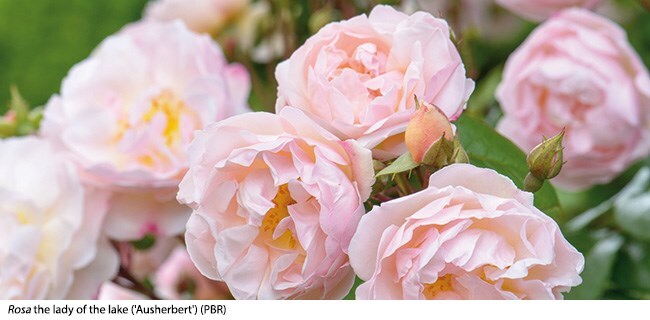
If something more vigorous is needed for a north-facing position follow Vita Sackville-West’s advice and plant the versatile Noisette rose 'Madame Alfred Carrière'. It’s in many rose buffs ‘Top Ten’ and can be grown anywhere. The foliage is shiny and healthy, the easily-trained stems are smooth and thornless, and the blush-white roses begin in June and linger on towards Christmas.
Finally ‘Gloire de Dijon’ has to get a mention as it can be a joy with its really fragrant, heavy-headed flowers that hover between buff-yellow, apricot and salmon-pink. The circular blooms swirl like whipped fondant icing enclosed by a cup-like sweep of outer petals. Its main flush is in June, with a few now and again afterwards, and the scent is heavenly.
Shrubby and Healthy
 Lots of roses escape black spot (Diplocarpon rosae) and they include Rugosa roses bred from a shrubby Japanese species found naturally on poor, sandy soil. These thrive in most gardens, although lime-rich soil will produce yellow, chlorotic foliage. One of the finest, ‘Roseraie de L'Haÿ’ (1901) was named after a notable French rose garden of the same name. The serrated foliage is a rich-green, darker than most Rugosa, and the almost double purple-pink flowers appear from May onwards, but don’t expect many hips. The semi-double white, ‘Blanche Double de Coubert’, makes an excellent hedge but again there are few red hips. Light pruning in spring is best, because Rugosas tend to get some dieback following cold winters. Shrub roses and English roses are never pruned hard.
Lots of roses escape black spot (Diplocarpon rosae) and they include Rugosa roses bred from a shrubby Japanese species found naturally on poor, sandy soil. These thrive in most gardens, although lime-rich soil will produce yellow, chlorotic foliage. One of the finest, ‘Roseraie de L'Haÿ’ (1901) was named after a notable French rose garden of the same name. The serrated foliage is a rich-green, darker than most Rugosa, and the almost double purple-pink flowers appear from May onwards, but don’t expect many hips. The semi-double white, ‘Blanche Double de Coubert’, makes an excellent hedge but again there are few red hips. Light pruning in spring is best, because Rugosas tend to get some dieback following cold winters. Shrub roses and English roses are never pruned hard.
One of the loveliest old-fashioned shrub roses is Rosa 'Königin von Dänemark'. It has the most delicious, fully double, very fragrant, deep to lighter pink flowers in midsummer, with grey-green foliage to offset the blooms. Further more will tolerate some shade and it is known to be disease resistant.
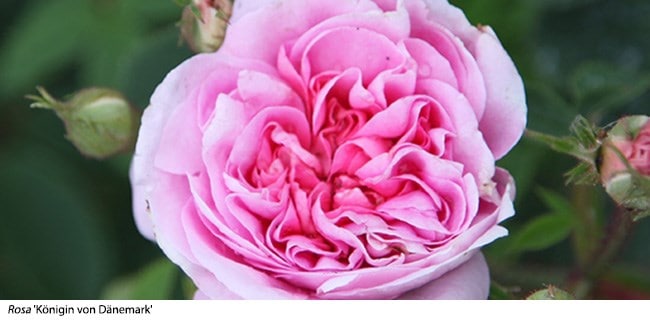
Health and vigour are a quality also found in the Reverend Pemberton’s Hybrid Musks. These roses, bred between 1924 and 1939, are garden classics and they flower well in July and then again in late-summer and autumn. They are all fragrant and healthy. ‘Buff Beauty’ (1939 ) is from the Pemberton stable. It was introduced by Ann Bentall, the widow of Joseph Pemberton’s head gardener. Large trusses of warm-apricot flowers age to sunset-pink against reddish foliage with a gorgeous, tea rose-scent to be enjoyed close to an entrance or seating area if possible ‘Buff Beauty’ adores a warm position and although it takes a few years to get established it’s a show-stopper.
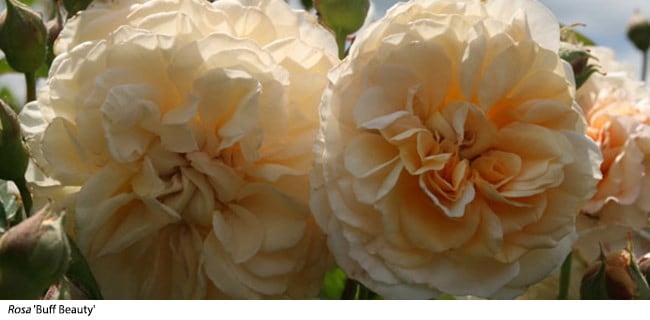
The Hybrid Musks are also trouble-free when it comes to disease and they are tolerant of poorer soil too, possibly because they were bred in the relatively dry county of Essex. David Austin's Rosa William and Catherine ('Ausrapper') is a hybrid musk with an intoxicating myrrh fragrance. The flowers are exquisite, starting with a gentle apricot flush, turning to a cream, then quickly to form white cupped, many petalled blooms. It is has a bushy habit and strong resistance to disease.‘Bonica’, another superb rose for poorer soil, was raised in France by Meilland in 1982. The clusters of bright-pink flowers glow in a border and it’s low-growing and compact, bearing between a dozen to fifteen flowers per cluster throughout summer. This is one rose worth planting en masse, because it’s rarely out of flower so your garden can be full of roses from June onwards.
So don't forget, now is the time to place your rose order!












